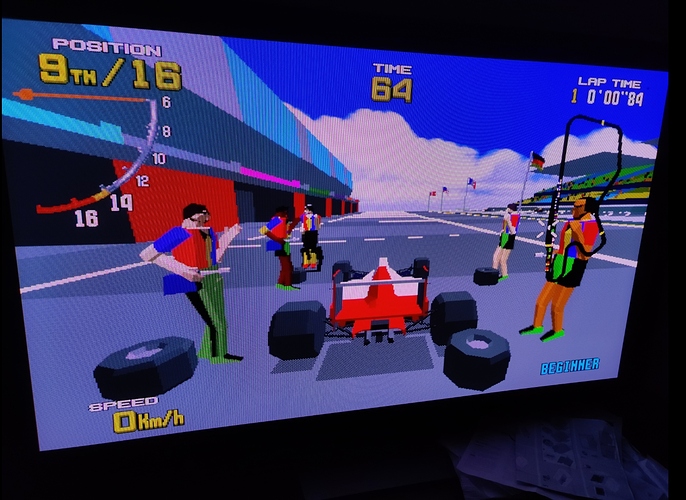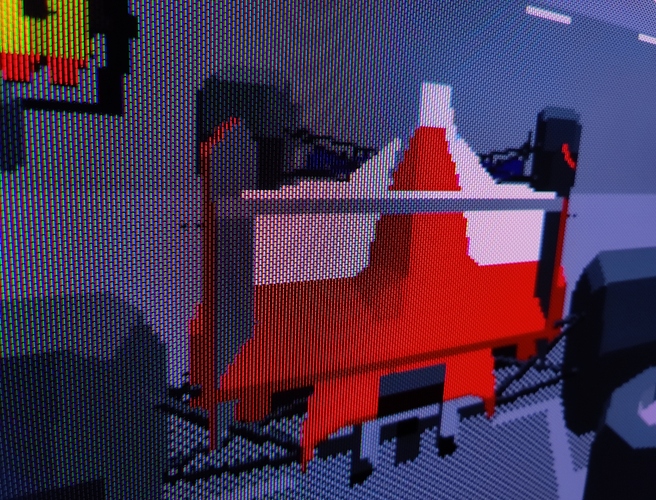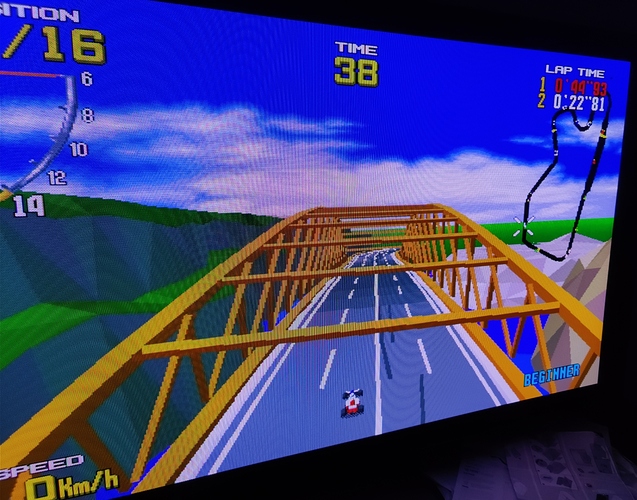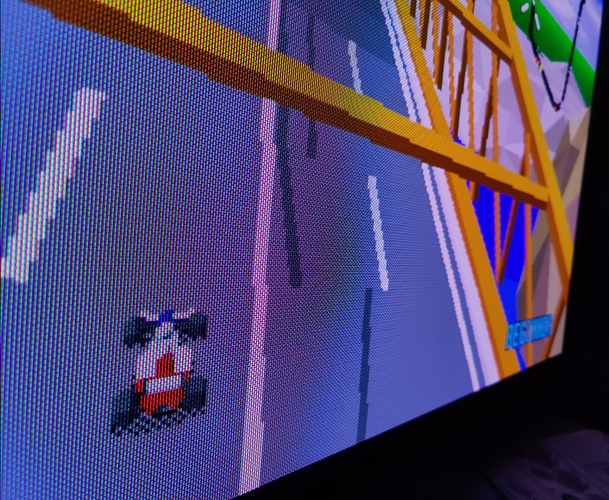This is a QD-OLED so it’s a RGB mask layout the same as my LCD. I suppose I should qualify that in my shader parameters shouldn’t I! In terms of the triangle sub pixel arrangement and aperture grille I’d say it’s absolutely fine. For slot masks up close you can see a little bobble but as you draw away your eyes snap them straight. Basically at a foot away from this six foot screen you can see the bobble but at a foot and a half you see a straight normal slot mask. As for dot masks I haven’t tested them yet - these will be the interesting ones!
With regards to the CRT mask accurate this isn’t really an issue with the shader per se it’s to do with rec. 2020 and using HDR which effects all shaders in HDR. Admittedly HDR is a key part of the Megatron so it’s fair argument in one respect.
So does HDR/rec. 2020 break the masks? I’d argue it doesn’t in practical terms but technically you can argue it does. Certainly in person with the naked eye with your nose pressed up against the screen you can’t see the green subpixels being on in the red screen - the red screen is red and made up of faked red phosphors as far as you’re concerned.
This kind of makes sense as the red rec. 2020 sub pixels are trying to make the same colour as the red rec.709 pixels or indeed the red rec.601 phosphors which were both slightly greener - but you wouldn’t at the time say they were greeney red you would just say they were red.
The question Im trying to figure out is when I output pure red from my shader is the TV turning on those green sub pixels as its doing in mask accurate mode. Is this windows, the gpu driver or the TV converting that red into rec. 2020’s equivalent red. This may show us a bug somewhere which would be important to fix.
Congrats on the tv purchase.
Can you take some slot mask pics for us?
Rest assured I have got them - I’ll share them soon!
Honestly thinking of selling my C1 for this. I never remedied the sound lag issue that plagues my C1 and LG offered little to no support to fix my issue. If CRT mask emulation is superior to standard OLED’s I’m sold.
Here’s some pics of slot mask on Sega Virtua Racing (a typical look of Virtua arcade game cabinets) on the S95B. When you zoom right in you can see the ‘bobble’ on the horizontal wires but when you zoom out it vanishes which is how it works in person.
Do zoom in on the third close up picture to see both the slot mask and pixels making up the phosphors in detail and in HDR. Apart from the bobble even the slightly larger gap between the blue and red pixels (vertical wires) work well as they seem to match the height of the horizontal wires
The subpixels do look a bit strange in the extreme close up, but perhaps the glow disguises that at greater than nose-to-screen distances. I think what we need are some side-by-side comparisons! Time to see if it passes the Pepsi challenge.
Yeah there’s definitely no getting around the fact it’s going to have slightly odd spacing but you need a camera set to 100 and below ISO to tell I’d say - it’s just too bright to see the individual sub pixels that well but I need to setup my PC in the front room again and find time now that Ive digested the photos a bit and definitely we need to do a pepsi challenge!!!
Just to add one thing I noticed is the larger spacing between the blue and red phosphors in the images but maybe you could argue that’s more like an actual CRT with it’s slightly wider wires between the triads? 🤷
Well I was thinking theoretically it should be possible to emulate an electron beam’s width with enough resolution.
Not sure if you were aware but there is this thread on Shmup Forums which details how you can modify the TVL of a CRT to whatever you want by modifying the spot size(electron beam width) There are some very in-depth explanations here(some from Texas Instruments) which might be of use to you https://shmups.system11.org/viewtopic.php?f=6&t=67124&sid=d36961dab98500a962e7bc97015f63c0
Seeing as both CRT and Modern Displays are Raster-type displays, given enough resolution it should therefore be able to recreate the same effect. Although I’m unsure of the math/method involved to do it and how much resolution you would need to do it. I know for a fact though that CRTs were not pixel-perfect by design, at least the ones that used masks. What I’m thinking here is more “line-perfect” rather than pixel perfect.
2160/4=540tvl Pretty sure it’s 3840/4 = 960TVL Or for 4:3 2880/4 = 720TVL Since TVL is the Horizontal Resolution not the Vertical one
For 2: Why would you possibly need that provided by the OS or the Graphics Card? A 3rd party open source software solution would work.
I’ll come back to 1).
As to 2) maybe I’m misunderstanding what you’re after? As far as I can tell youre after a full screen shader that runs over the entire Windows desktop at all times. Have I got that right? If not then why wouldnt ReShade work for you?
So assuming you want the former you might be able to do something like via the likes of a virtual monitor AKA Parsec but obviously you’d need shader support in the virtual monitor driver rather like I was saying for the Nvidia or AMD drivers.
Possibly you might be able to capture the desktop like the snipping tool and display a full screen app over the top but then how do you feed all the mouse keyboard etc events to the Windows subsystem and on top of that good luck with full screen apps. I can’t see how that would realistically work.
So to 1) changing the beam spot size isn’t increasing the TVL at all, although I can see it having the effect of doing that. Your TVL is basically fixed to the number of phosphor triads you have and that can’t change. Changing the spot size effectively makes the beam more reactive to the current phosphor and underlying image giving a sharper image.
With shaders you can do this way more accurately as can be seen especially in Reshade where you can have effective TVLs of 2160p if the underlying content is 3840 horizontal resolution.
Basically we change the spot size already and you can change that with the horizontal (and vertical) attack in the Megatron.
TVL is the count of vertical lines across the screen to the height of the screen across i.e a square. That’s why we just use the vertical resolution.
Adding to what MajorPain just stated, total TV lines was used by some TV manufacturers like Panasonic and JVC, since more = sounds better. Some CRT spec sheets of monitors on the other hand state a line count for center and another for corners. If you read the thread, the author actually states TVL is a stupid metric after adressing exactly the confusion with total lines by another poster on page 4, but there are also statements of why it can be useful and other things that factor in and what the author was trying to accomplish.
Updated my AutoHDR ReShade addon to work with ReShade 5.4.2 and Sony Megatron for ReShade to latest Retroarch version. You still have to faff about in the fx file to set the right resolution for the intermediate buffers if you want something different to 240p but that’s where ReShade is right now.
Anyway here are the links:
And some pictures of Dead Cells in 240p mode:
Nice. Are these photos of your new OLED? Can we run reshade over scummvm? The libretro core is quite behind the native app version
There’s an updated core that builds from latest upstream git, it’s just not on the buildbot (yet). You can get it (and the required helper files) from https://github.com/hunterk/libretro_builds
No they’re of my LCD. That I suppose is something to say I think my LCD is pretty comparable to the QD-OLED to be honest - just it’s on a smaller scale. Not sure about ReShade and Scummvm - my AutoHDR plugin works with both D3D11 and D3D12.
EDIT: all what I’ve just said is nonsense the OLED had gone into some power saving mode! Anyway I’ll keep this here to embarrass myself and entertain you lot.  I’ll redo this properly now…
I’ll redo this properly now…
Here you go @nesguy 40 year old CRT technology vs cutting edge QD-OLED. Id say it’s about 3-0 to the 40 year technology.
The difference in motion is of course night and day and STILL the OLED is no where near the brightness level of the CRT even if it feels really bright it’s still no where near as bright as the CRT.
Where I’d say the QD-OLED wins out is in size obviously and then if you go off piste with the colours - the QD-OLED can get incredibly saturated colours which is nice to look at in itself if not that accurate - same goes for the LCD.
Now have I got these two as accurate as I did with the LCD, no certainly not but my camera is maybe adding quite a bit of noise because it’s got to be further away than with the LCD because of the size of OLED.
Anyway an interesting test and maybe I can add accuracy a little more if I try out @rafan curves not sure but worth a punt (I’ve been working on something for you @rafan that I hope you’ll like)
This is actually a lot closer in person a lot closer. My camera doesn’t like the moire effects off the OLED at the distance it’s at.
Anyway here are the two images the OLED I’d say is equally as bright as the CRT. They are closer and both these shots are ISO 100.
You can probably use manual focus to get around this. It also happens to me, especially when using Auto Focus until I get the distance and angle right.
With manual it’s a bit easier but I can see the closeness of the fine details despite the colour not looking correct in the photo.
What about motion? Are you able to use BFI?
I tried manual as well before and my phone camera still does the same. In motion the CRT destroys the OLED in terms of clarity (I like the Megadrive’s Dynamite Heady first level’s foreground layer and try to read the signage) although I haven’t tried BFI yet as I haven’t found the option but seen as the OLED only just matches the CRT for brightness BFI will obviously unbalance that. I will try it though once I find it - game mode is currently borked appears as they are scaling the image from what looks like 1080p nasty - others must be complaining about this so I’m hoping it gets fixed in a firmware update.
















